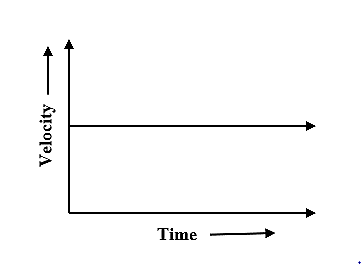
Draw a velocity-time graph for a uniform accelerated motion. What does its slope depict?
Answer
481.2k+ views
Hint: Use relation between acceleration, velocity and time to find the nature of the graph. The Velocity-time graph gives acceleration as slope. In non-uniform motion acceleration changes, eventually slope changes. The slope is either increasing or decreasing. While, in uniform motion, the acceleration remains constant, thus slope remains the same.
Complete solution:
The velocity-time graph for a uniform accelerated motion is shown below.

We know formula for acceleration is given by,
where,
a: Acceleration
v: Velocity
t : Time
From the above equation, it can be understood that the slope calculated from the velocity-time graph gives acceleration. Thus, the velocity-time graph of a uniformly accelerated motion is a straight line graph inclining towards the time axis on the X-axis. If the body is moving with a positive constant acceleration then the graph slopes upward. In case, if the body is moving with negative constant acceleration then the graph slopes downward.
Additional Information:
If the acceleration of the body is zero then the slope of the graph will also be zero. Then, the graph will just be a straight horizontal line with zero slope. Such a motion is known as uniform motion with zero acceleration. The graph for zero acceleration is shown below.

Note:
Students must not confuse between the nature of the graph for a uniform accelerated motion and non-uniform accelerated motion. The velocity-time graph for uniform accelerated motion is a straight line. Whereas, for non-uniform accelerated motion it gives a curved line. If we draw a distance versus time graph, it will show the same nature of graph for uniform motion and non-uniform motion as it is in velocity versus time graph.
Complete solution:
The velocity-time graph for a uniform accelerated motion is shown below.

We know formula for acceleration is given by,
where,
a: Acceleration
v: Velocity
t : Time
From the above equation, it can be understood that the slope calculated from the velocity-time graph gives acceleration. Thus, the velocity-time graph of a uniformly accelerated motion is a straight line graph inclining towards the time axis on the X-axis. If the body is moving with a positive constant acceleration then the graph slopes upward. In case, if the body is moving with negative constant acceleration then the graph slopes downward.
Additional Information:
If the acceleration of the body is zero then the slope of the graph will also be zero. Then, the graph will just be a straight horizontal line with zero slope. Such a motion is known as uniform motion with zero acceleration. The graph for zero acceleration is shown below.

Note:
Students must not confuse between the nature of the graph for a uniform accelerated motion and non-uniform accelerated motion. The velocity-time graph for uniform accelerated motion is a straight line. Whereas, for non-uniform accelerated motion it gives a curved line. If we draw a distance versus time graph, it will show the same nature of graph for uniform motion and non-uniform motion as it is in velocity versus time graph.
Recently Updated Pages
Master Class 12 Business Studies: Engaging Questions & Answers for Success

Master Class 12 English: Engaging Questions & Answers for Success

Master Class 12 Social Science: Engaging Questions & Answers for Success

Master Class 12 Chemistry: Engaging Questions & Answers for Success

Class 12 Question and Answer - Your Ultimate Solutions Guide

Master Class 11 Economics: Engaging Questions & Answers for Success

Trending doubts
Draw a labelled sketch of the human eye class 12 physics CBSE

a Tabulate the differences in the characteristics of class 12 chemistry CBSE

Which one of the following is a true fish A Jellyfish class 12 biology CBSE

Why is the cell called the structural and functional class 12 biology CBSE

Differentiate between homogeneous and heterogeneous class 12 chemistry CBSE

Write the difference between solid liquid and gas class 12 chemistry CBSE




